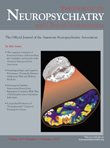Exploring the Relationship Between Panic Disorder and Parkinson’s Disease
SIR: I read with interest the recent report by Matsui et al. 1 in which the authors highlighted a patient who was diagnosed with Parkinson’s disease shortly after a panic attack. Though there is strong biological basis for the association of panic disorder with Parkinson’s disease, the case report raises a number of unanswered questions. Based on the presentation, one cannot exclude the possibility of chance occurrence of the two conditions. The onset of parkinsonian symptoms in their patient may be much earlier than the date when the patient first noticed them. It may be more convincing if longitudinal data were available where it can be shown that the two problems progressed in tandem. Furthermore, availability of detailed information on the patient’s premorbid personality and family history of psychiatric disorder would have been useful.
I think the more interesting clinical question would be to determine the proportion of Parkinson’s disease patients who present with panic disorder before or at the time of diagnosis. To address that, I interviewed and examined 53 consecutive newly diagnosed Parkinson’s disease patients in our movement disorders clinic for evidence and history of panic disorder prior to the diagnosis. This was carried out as part of our routine clinical care, and I also received institutional ethics approval for evaluation of nonmotor symptoms in Parkinson’s disease. The patients’ mean age of onset was 62 (SD=11.5) years, with about 50% men and with the Hoehn and Yahr stage between 1 to 4. I found that none of our patients had history or evidence of panic disorder prior to Parkinson’s disease diagnosis. This suggests that panic disorder as a presentation prior to the onset of Parkinson’s disease symptoms was uncommon, at least in our population. Whether our finding reflects ethnicity-specific effects of phenotypic expression remains to be clarified.
However, I agree that psychiatric nonmotor symptoms, such as anxiety, depression, and panic disorder, can be disabling in Parkinson’s disease patients, 2 , 3 and these are relatively less well studied than motor disability. Among anxiety disorders, it appears that generalized anxiety disorder, panic disorder and social phobias are most frequently encountered, and anxiety may develop before motor features. 3 To further our understanding of the pathophysiology of panic disorder in Parkinson’s disease, more prospective studies are needed to examine their cause-effect relationship and the temporal relationship of panic disorder with other psychiatric and cognitive disturbances.
1 . Matsui H, Udaka F, Oda M, et al: Parkinson’s disease following panic disorder. J Neuropsychiatry Clin Neurosci 2006;18:130Google Scholar
2 . Witjas T, Kaphan E, Azulay JP, et al: Nonmotor fluctuations in parkinson’s disease: frequent and disabling. Neurology 2002; 59:408–413Google Scholar
3 . Anxiety disorders in Parkinson’s disease. Adv Neurol 2005; 96:42–55Google Scholar



